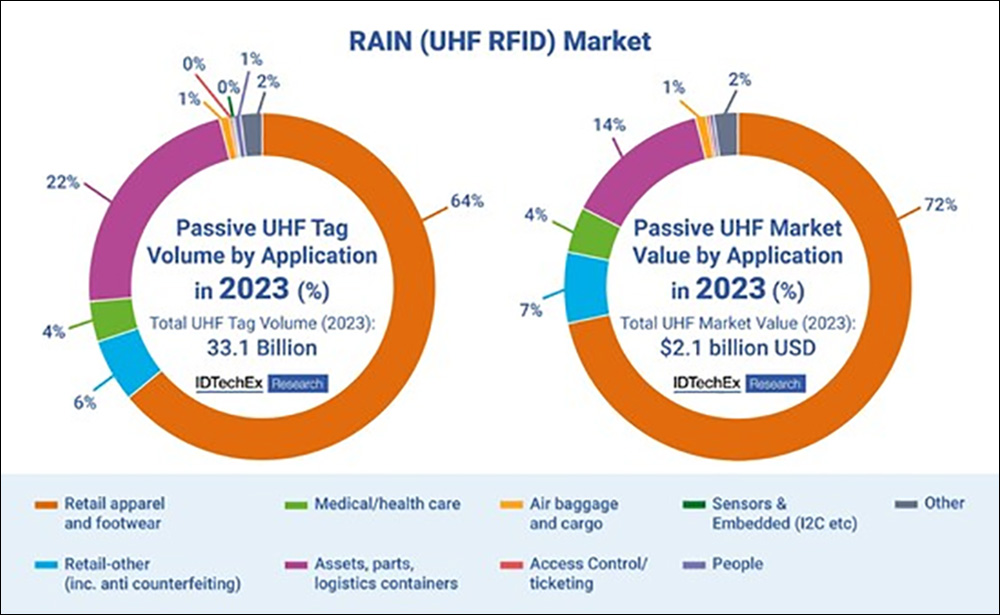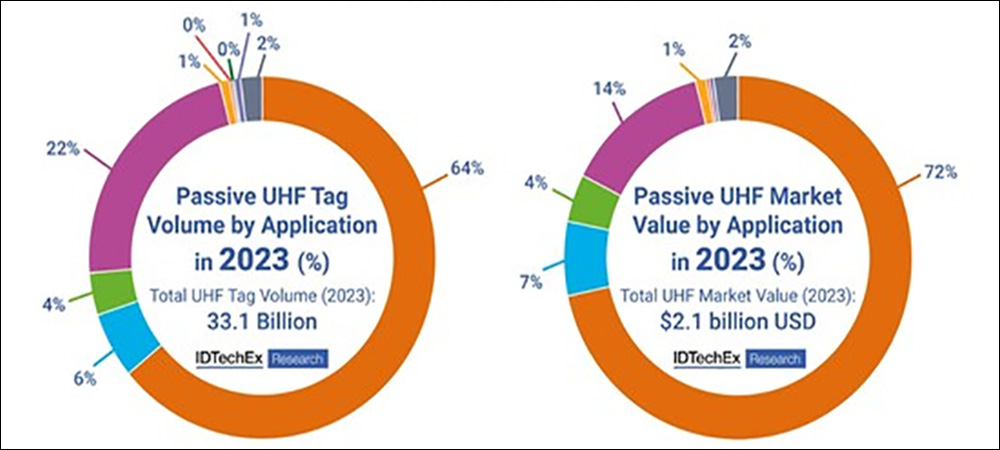The radio frequency identification (RFID) industry is expected to maintain its current growth trajectory, according to IDTechEx, which forecasts a market value of $14 billion this year—an increase from last year’s $12.8 billion. This market value, according to the company, encompasses various RFID form factors, including labels, cards, fobs and tags, as well as readers, software and services for both active and passive RFID technologies. Among these, IDTechEx says the passive RFID tag segment stands out as the largest, comprising more than half of the total RFID market.
The UHF RFID market, IDTechEx reports, is predominantly driven by the retail apparel sector, which accounts for 64 percent of the market share by tag volume and 72 percent by value. While nearly 24 billion RFID labels are expected to be used in retail apparel tagging by 2023, the company indicates, the total addressable market for retail apparel is believed to be around 80 billion tags annually, indicating ample growth opportunities. According to IDTechEx, the ecosystem’s maturity and the availability of solution providers in the retail apparel sector have been crucial in the successful adoption of RFID technologies.

Low cost, enabling infrastructure and other advantages, such as improved stock monitoring, better customer service and access to new marketing information, have also contributed to the widespread adoption of UHF RFID technologies in retail apparel applications. Other retail sectors, such as electronics, soft furnishings and home appliances, are also expected to show strong growth in RFID tagging, largely driven by Walmart’s mandate (see Manufacturers Have Inventory Problems—Walmart’s RFID Relaunch Has Answers, Walmart’s RFID Mandate: A Prequel to Wider Retail Adoption, The Walmart RFID Program and Walmart Added to RFID Journal LIVE! Conference Program).
While other industries have been slower in adopting RFID technology, compared to the tagging of retail apparel, growth is anticipated in the supply chain and logistics industry as well, which IDTechEx says accounts for 22 percent of the market share by tag volume and 14 percent by market value. The pandemic has also accelerated the adoption of UHF RFID technology, the company adds, with increasing digitalization across various industries and continued reduction in tag costs contributing to the growth of the UHF RFID market.
The RFID market is poised to expand in the coming years, IDTechEx reports, fueled by various factors, including the pandemic, cost reductions and lighthouse projects demonstrating the potential of RFID technology in improving operational efficiency and productivity. However, the company notes that the UHF reader network is still primarily a business tool, with the cost of reader smartphones targeted toward industry use rather than consumers.
IDTechEx says HF RFID is being used for secure access, transit applications and payments. This year, approximately 5.1 billion HF tags will be sold, equivalent to a market value of $5.2 billion. The HF market value is larger than the UHF market value, despite the smaller tag volume, due to the higher HF tag average selling price (ASP). Contactless cards and fobs are dominating the HF market, IDTechEx reports, but this is expected to decline in the medium term as emerging digital methods gain traction rapidly, such as mobile payments and QR codes. The second largest market for HF tags by value is the passport sector.
Near Field Communication (NFC) applications beyond payments will continue to grow to several hundred million labels in 2023, IDTechEx predicts, though most are still relatively low-volume deployments across many projects, such as Bluetooth pairing, gaming and smart packaging, with the latter expected to have the highest-volume opportunity. However, the company notes, no NFC provider has yet demonstrated a strong enough payback or value for mass deployment of NFC on smart packaging at current NFC label prices. NFC labels would need to cost less than 1 cent apiece before being widely deployed on packaging, IDTechEx says, whereas the current price point is around 6 cents. Flexible ICs and new technologies may drive that price down.
Overall, the RFID market is expanding, though it faces various obstacles, including global supply chain problems and macroeconomic conditions. IDTechEx conducted primary interviews and found that most firms believe the situation will improve by early 2024. The economic downturn has resulted in some industries reducing their purchases of RFID tags, especially in some initiative projects, which could slow down the market’s growth rate. In addition, there are other ongoing challenges that the RFID industry must address to ensure sustainable growth, including education, regulation, ecosystem establishment and cost reduction.
IDTechEx’s RFID market research report, “RFID Forecasts, Players and Opportunities 2023-2033,” provides an overview covering passive, battery-assisted passive, active and chipless RFID technologies, along with the players and markets. This report analyzes primary data gathered through interviews conducted throughout the value chain, as well as secondary data from available sources.


